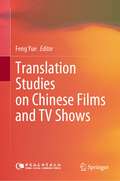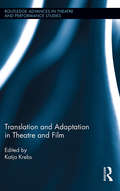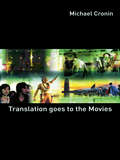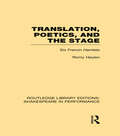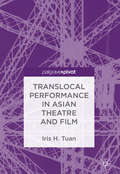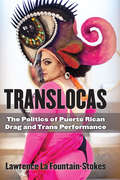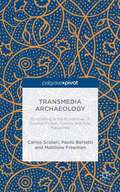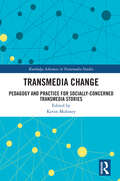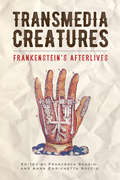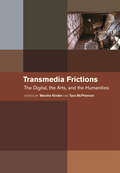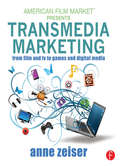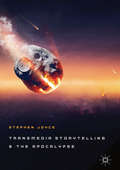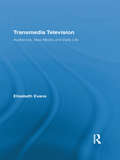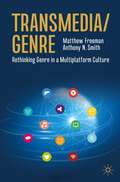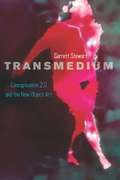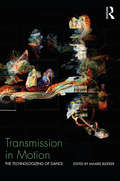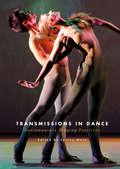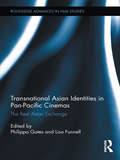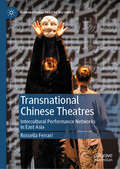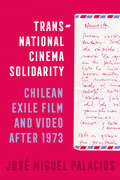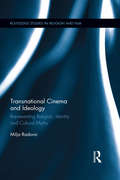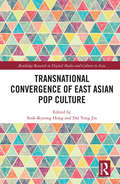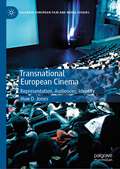- Table View
- List View
Translation Studies on Chinese Films and TV Shows
by Feng YueThis book explores translation strategies for films and TV programs. On the basis of case studies on subtitle translations, it argues that translators are expected to take into consideration not only linguistic and cultural differences but also the limits of time and space. Based on the editor’s experience working as a translator for TV, journalist, and narrator, this book proposes employing editorial translation for TV translation. Further, in light of statistics on international audiences’ views on Chinese films, it suggests striking a balance between conveying cultural messages and providing good entertainment.
Translation and Adaptation in Theatre and Film (Routledge Advances in Theatre & Performance Studies)
by Katja KrebsThis book provides a pioneering and provocative exploration of the rich synergies between adaptation studies and translation studies and is the first genuine attempt to discuss the rather loose usage of the concepts of translation and adaptation in terms of theatre and film. At the heart of this collection is the proposition that translation studies and adaptation studies have much to offer each other in practical and theoretical terms and can no longer exist independently from one another. As a result, it generates productive ideas within the contact zone between these two fields of study, both through new theoretical paradigms and detailed case studies. Such closely intertwined areas as translation and adaptation need to encounter each other’s methodologies and perspectives in order to develop ever more rigorous approaches to the study of adaptation and translation phenomena, challenging current assumptions and prejudices in terms of both. The book includes contributions as diverse yet interrelated as Bakhtin’s notion of translation and adaptation, Bollywood adaptations of Shakespeare’s Othello, and an analysis of performance practice, itself arguably an adaptive practice, which uses a variety of languages from English and Greek to British and International Sign-Language. As translation and adaptation practices are an integral part of global cultural and political activities and agendas, it is ever more important to study such occurrences of rewriting and reshaping. By exploring and investigating interdisciplinary and cross-cultural perspectives and approaches, this volume investigates the impact such occurrences of rewriting have on the constructions and experiences of cultures while at the same time developing a rigorous methodological framework which will form the basis of future scholarship on performance and film, translation and adaptation.
Translation goes to the Movies
by Michael CroninThis highly accessible introduction to translation theory, written by a leading author in the field, uses the genre of film to bring the main themes in translation to life. Through analyzing films as diverse as the Marx Brothers’ A Night at the Opera, The Star Wars Trilogies and Lost in Translation, the reader is encouraged to think about both issues and problems of translation as they are played out on the screen and issues of filmic representation through examining the translation dimension of specific films. In highlighting how translation has featured in both mainstream commercial and arthouse films over the years, Cronin shows how translation has been a concern of filmmakers dealing with questions of culture, identity, conflict and representation. This book is a lively and accessible text for translation theory courses and offers a new and largely unexplored approach to topics of identity and representation on screen. Translation Goes to the Movies will be of interest to those on translation studies and film studies courses.
Translation, Poetics, and the Stage: Six French Hamlets (Routledge Library Editions: Shakespeare in Performance)
by Romy HeylenThis book establishes an analytical model for the description of existing translations in their historical context within a framework suggested by systemic concepts of literature. It argues against mainstream 20th-century translation theory and, by proposing a socio-cultural model of translation, takes into account how a translation functions in the receiving culture. The case studies of successive translations of "Hamlet" in France from the eighteenth century neoclassical version of Jean-Francois Ducis to the 20th-century Lacanian, post-structuralist stage production of Daniel Mesguich show the translator at work. Each chapter focuses on a different aspect of the changing theatrical and literary norms to which translators through the ages have been bound by the expectations both of their audiences and the literary establishment.
Translocal Performance in Asian Theatre and Film
by Iris H. TuanThis pivot offers an innovative, trans-local perspective on performance studies in the era of digital technology, considering a range of content from theater to opera, film, dance, and musical theatre. It examines theatre performing arts and film in terms of aesthetics, gender studies, and identity politics, and showcases the value of human accomplishments in theatre and film and their representative artistic works. It also addresses key issues within performance studies, such as gender, class, race, ethnicity, identity, and how minorities portray their ethnicity stories. This book links the trans-national and the trans-local and considers how emerging mobile geographies and new methodologies of interpreting performance in theatre and film reflect the transformations of our understanding of geopolitical time and space.
Translocas: The Politics of Puerto Rican Drag and Trans Performance (Triangulations: Lesbian/Gay/Queer Theater/Drama/Performance)
by Lawrence La Fountain-StokesTranslocas focuses on drag and transgender performance and activism in Puerto Rico and its diaspora. Arguing for its political potential, Lawrence La Fountain-Stokes explores the social and cultural disruptions caused by Latin American and Latinx “locas” (effeminate men, drag queens, transgender performers, and unruly women) and the various forms of violence to which queer individuals in Puerto Rico and the U.S. are subjected. This interdisciplinary, auto-ethnographic, queer-of-color performance studies book explores the lives and work of contemporary performers and activists including Sylvia Rivera, Nina Flowers, Freddie Mercado, Javier Cardona, Jorge Merced, Erika Lopez, Holly Woodlawn, Monica Beverly Hillz, Lady Catiria, and Barbra Herr; television programs such as RuPaul’s Drag Race; films such as Paris Is Burning, The Salt Mines, and Mala Mala; and literary works by authors such as Mayra Santos-Febres and Manuel Ramos Otero. Lawrence La Fountain-Stokes, a drag performer himself, demonstrates how each destabilizes (and sometimes reifies) dominant notions of gender and sexuality through drag and their embodied transgender expression. These performances provide a means to explore and critique issues of race, class, poverty, national identity, and migratory displacement while they posit a relationship between audiences and performers that has a ritual-like, communal dimension. The book also analyzes the murders of Jorge Steven López Mercado and Kevin Fret in Puerto Rico, and invites readers to challenge, question, and expand their knowledge about queer life, drag, trans performance, and Puerto Rican identity in the Caribbean and the diaspora. The author also pays careful attention to transgender experience, highlighting how trans activists and performers mold their bodies, promote social change, and create community in a context that oscillates between glamour and abjection.
Transmedia Archaeology: Storytelling in the Borderlines of Science Fiction, Comics and Pulp Magazines
by Matthew Freeman Carlos A. Scolari Paolo BertettiIn this book, the authors examine manifestations of transmedia storytelling in different historical periods and countries, spanning the UK, the US and Argentina. It takes us into the worlds of Conan the Barbarian, Superman and El Eternauta, introduces us to the archaeology of transmedia, and reinstates the fact that it's not a new phenomenon.
Transmedia Change: Pedagogy and Practice for Socially-Concerned Transmedia Stories (Routledge Advances in Transmedia Studies)
by Kevin MoloneyThis book examines and illustrates the use of design principles, design thinking, and other empathy research techniques in university and public settings, to plan and ethically target socially-concerned transmedia stories and evaluate their success through user experience testing methods. All media industries continue to adjust to a dispersed, diverse, and dilettante mediascape where reaching a large global audience may be easy but communicating with a decisive and engaged public is more difficult. This challenge is arguably toughest for communicators who work to engage a public with reality rather than escape. The chapters in this volume outline the pedagogy and practice of design, empathy research methods for story development, transmedia logics for socially-concerned stories, development of community engagement and the embrace of collective narrative, art and science research collaboration, the role of mixed and virtual reality in prosocial communication, ethical audience targeting, and user experience testing for storytelling campaigns. Each broad topic includes case examples and full case studies of each stage in production. Offering a detailed exploration of a fast-emerging area, this book will be of great relevance to researchers and university teachers of socially-concerned transmedia storytelling in fields such as journalism, documentary filmmaking, education, and activism.
Transmedia Creatures: Frankenstein’s Afterlives
by Claire Nally Diego Saglia Ruth Heholt Andrew McInnes Lidia De Michelis Eleanor Beal Gino Roncaglia Claudia Gualtieri Federico Meschini Enrico Reggiani Daniele Pio Buenza Janet LarsonOn the 200th anniversary of the first edition of Mary Shelley’s Frankenstein, Transmedia Creatures presents studies of Frankenstein by international scholars from converging disciplines such as humanities, musicology, film studies, television studies, English and digital humanities. These innovative contributions investigate the afterlives of a novel taught in a disparate array of courses - Frankenstein disturbs and transcends boundaries, be they political, ethical, theological, aesthetic, and not least of media, ensuring its vibrant presence in contemporary popular culture. Transmedia Creatures highlights how cultural content is redistributed through multiple media, forms and modes of production (including user-generated ones from “below”) that often appear synchronously and dismantle and renew established readings of the text, while at the same time incorporating and revitalizing aspects that have always been central to it. The authors engage with concepts, value systems and aesthetic-moral categories—among them the family, horror, monstrosity, diversity, education, risk, technology, the body—from a variety of contemporary approaches and highly original perspectives, which yields new connections. Ultimately, Frankenstein, as evidenced by this collection, is paradoxically enriched by the heteroglossia of preconceptions, misreadings, and overreadings that attend it, and that reveal the complex interweaving of perceptions and responses it generates. Published by Bucknell University Press. Distributed worldwide by Rutgers University Press.
Transmedia Frictions
by Tara Mcpherson Marsha KinderEditors Marsha Kinder and Tara McPherson present an authoritative collection of essays on the continuing debates over medium specificity and the politics of the digital arts. Comparing the term "transmedia" with "transnational," they show that the movement beyond specific media or nations does not invalidate those entities but makes us look more closely at the cultural specificity of each combination. In two parts, the book stages debates across essays, creating dialogues that give different narrative accounts of what is historically and ideologically at stake in medium specificity and digital politics. Each part includes a substantive introduction by one of the editors. Part 1 examines precursors, contemporary theorists, and artists who are protagonists in this discursive drama, focusing on how the transmedia frictions and continuities between old and new forms can be read most productively: N. Katherine Hayles and Lev Manovich redefine medium specificity, Edward Branigan and Yuri Tsivian explore nondigital precursors, Steve Anderson and Stephen Mamber assess contemporary archival histories, and Grahame Weinbren and Caroline Bassett defend the open-ended mobility of newly emergent media. In part 2, trios of essays address various ideologies of the digital: John Hess and Patricia R. Zimmerman, Herman Gray, and David Wade Crane redraw contours of race, space, and the margins; Eric Gordon, Cristina Venegas, and John T. Caldwell unearth database cities, portable homelands, and virtual fieldwork; and Mark B.N. Hansen, Holly Willis, and Rafael Lozano-Hemmer and Guillermo Gómez-Peña examine interactive bodies transformed by shock, gender, and color. An invaluable reference work in the field of visual media studies, Transmedia Frictions provides sound historical perspective on the social and political aspects of the interactive digital arts, demonstrating that they are never neutral or innocent.
Transmedia Frictions: The Digital, the Arts, and the Humanities
by Marsha Kinder and Tara McPhersonEditors Marsha Kinder and Tara McPherson present an authoritative collection of essays on the continuing debates over medium specificity and the politics of the digital arts. Comparing the term "transmedia" with "transnational," they show that the movement beyond specific media or nations does not invalidate those entities but makes us look more closely at the cultural specificity of each combination. In two parts, the book stages debates across essays, creating dialogues that give different narrative accounts of what is historically and ideologically at stake in medium specificity and digital politics. Each part includes a substantive introduction by one of the editors. Part 1 examines precursors, contemporary theorists, and artists who are protagonists in this discursive drama, focusing on how the transmedia frictions and continuities between old and new forms can be read most productively: N. Katherine Hayles and Lev Manovich redefine medium specificity, Edward Branigan and Yuri Tsivian explore nondigital precursors, Steve Anderson and Stephen Mamber assess contemporary archival histories, and Grahame Weinbren and Caroline Bassett defend the open-ended mobility of newly emergent media. In part 2, trios of essays address various ideologies of the digital: John Hess and Patricia R. Zimmerman, Herman Gray, and David Wade Crane redraw contours of race, space, and the margins; Eric Gordon, Cristina Venegas, and John T. Caldwell unearth database cities, portable homelands, and virtual fieldwork; and Mark B.N. Hansen, Holly Willis, and Rafael Lozano-Hemmer and Guillermo Gómez-Peña examine interactive bodies transformed by shock, gender, and color. An invaluable reference work in the field of visual media studies, Transmedia Frictions provides sound historical perspective on the social and political aspects of the interactive digital arts, demonstrating that they are never neutral or innocent.
Transmedia Marketing: From Film and TV to Games and Digital Media (American Film Market Presents)
by Anne ZeiserTransmedia Marketing: From Film and TV to Games and Digital Media skillfully guides media makers and media marketers through the rapidly changing world of entertainment and media marketing. Its groundbreaking transmedia approach integrates storytelling and marketing content creation across multiple media platforms – harnessing the power of audience to shape and promote your story. Through success stories, full color examples of effective marketing techniques in action, and insight from top entertainment professionals, Transmedia Marketing covers the fundamentals of a sound 21st century marketing and content plan. You’ll master the strategy behind conducting research, identifying target audiences, setting goals, and branding your project. And, you’ll learn first-hand how to execute your plan’s publicity, events, advertising, trailers, digital and interactive content, and social media. Transmedia Marketing enlivens these concepts with: Hundreds of vibrant examples from across media platforms – The Hunger Games, Prometheus, The Dark Knight, Bachelorette, The Lord of the Rings, Despicable Me 2, Food, Inc., Breaking Bad, House of Cards, Downton Abbey, Game of Thrones, Top Chef, Pokémon, BioShock Infinite, Minecraft, Outlast, Titanfall, LEGO Marvel Super Heroes, Halo 4, Lonelygirl15, Annoying Orange Real-world advice from 45 leading industry writers, directors, producers, composers, distributors, marketers, publicists, critics, journalists, attorneys, and executives from markets, festivals, awards, and guilds Powerful in-depth case studies showcasing successful approaches – A.I. Artificial Intelligence, Mad Men, Lizzie Bennet Diaries, Here Comes Honey Boo Boo, and Martin Scorsese Presents the Blues Extensive Web content at www.transmediamarketing.com featuring a primer on transmedia platforms – film, broadcast, print, games, digital media, and experiential media; expanded case studies; sample marketing plans and materials; and exclusive interviews With Transmedia Marketing, you’ll be fully versed in the art of marketing film, TV, games, and digital media and primed to write and achieve the winning plan for your next media project.
Transmedia Storytelling and the Apocalypse
by Stephen JoyceThis book confronts the question of why our culture is so fascinated by the apocalypse. It ultimately argues that while many see the post-apocalyptic genre as reflective of contemporary fears, it has actually co-evolved with the transformations in our mediascape to become a perfect vehicle for transmedia storytelling. The post-apocalyptic offers audiences a portal to a fantasy world that is at once strange and familiar, offers a high degree of internal consistency and completeness, and allows for a diversity of stories by different creative teams in the same story world. With case studies of franchises such as The Walking Dead and The Terminator, Transmedia Storytelling and the Apocalypse offers analyses of how shifts in media industries and reception cultures have promoted a new kind of open, world-building narrative across film, television, video games, and print. For transmedia scholars and fans of the genre, this book shows how the end of the world is really just the beginning…
Transmedia Television: Audiences, New Media, and Daily Life (Comedia)
by Elizabeth EvansThe early years of the twenty-first century have seen dramatic changes within the television industry. The development of the internet and mobile phone as platforms for content directly linked to television programming has offered a challenge to the television set’s status as the sole domestic access point to audio-visual dramatic content. Viewers can engage with ‘television’ without ever turning a television set on. Whilst there has already been some exploration of these changes, little attention has been paid to the audience and the extent to which these technologies are being integrated into their daily lives. Focusing on a particular period of rapid change and using case studies including Spooks, 24 and Doctor Who, Transmedia Television considers how the television industry has exploited emergent technologies and the extent to which audiences have embraced them. How has television content been transformed by shifts towards multiplatform strategies? What is the appeal of using game formats to lose oneself within a narrative world? How can television, with its ever larger screens and association with domesticity, be reconciled with the small portable, public technology of the mobile phone? What does the shift from television schedules to online downloading mean for our understanding of ‘the television audience’? Transmedia Television will consider how the relationship between television and daily life has been altered as a result of the industry’s development of emerging new media technologies, and what ‘television’ now means for its audiences.
Transmedia/Genre: Rethinking Genre in a Multiplatform Culture
by Matthew Freeman Anthony N. SmithThis book brings genre back to the forefront of the current transmedia trend. Genres are perhaps the most innately transmedial of media constructs, formed as they are from all kinds of industrial, technological and discursive phenomena. Yet, few have considered how genre works in a multiplatform context. This book does precisely that, making a uniquely transmedial contribution to the study of genre in the age of media convergence. The book interrogates how industrial, technological and participatory transformations of digital platforms and emerging technologies reshape workings of genre. The authors consider franchises such as Star Wars, streaming platforms such as Netflix, catch-up services such as ITV Hub, creative technologies such as virtual reality, and beyond. In setting the stage for the revival of genre theory in contemporary transmedia scholarship, this book pushes forward understandings of multiplatform media and the emerging form and function of genre across contemporary culture.
Transmediating the Whedonverse(s): Essays on Texts, Paratexts, and Metatexts
by Juliette C. Kitchens Julie L. HawkThis book explores the transmedial nature of the storyworlds created by and/or affiliated with television auteur, writer, and filmmaker, Joss Whedon. As such, the book addresses the ways in which Whedon’s storyworlds, or ‘verses, employ transmedia, both intrinsically as texts and extrinsically as these texts are consumed and, in some cases, reworked, by audiences. This collection walks readers through fan and scholar-fan engagement, intrinsic textual transmediality, and Whedon’s lasting influence on televisual and transmedia texts. In closing, the editors argue for the need to continue research into how the Whedonverse(s) lend themselves to transmedial study, engage audiences in ways that take advantage of multiple media, and encourage textual internalization of these engagements within audiences.
Transmedium: Conceptualism 2.0 and the New Object Art
by Garrett StewartIf you attend a contemporary art exhibition today, you’re unlikely to see much traditional painting or sculpture. Indeed, artists today are preoccupied with what happens when you leave behind assumptions about particular media—such as painting, or woodcuts—and instead focus on collisions between them, and the new forms and ideas that those collisions generate. Garrett Stewart in Transmedium dubs this new approach Conceptualism 2.0, an allusion in part to the computer images that are so often addressed by these works. A successor to 1960s Conceptualism, which posited that a material medium was unnecessary to the making of art, Conceptualism 2.0 features artworks that are transmedial, that place the aesthetic experience itself deliberately at the boundary between often incommensurable media. The result, Stewart shows, is art whose forced convergences break open new possibilities that are wholly surprising, intellectually enlightening, and often uncanny.
Transmission in Motion: The Technologizing of Dance
by Maaike BleekerHow can various technologies, from the more conventional to the very new, be used to archive, share and understand dance movement? How can they become part of new ways of creating dance? What does this tell us about the ways in which technology is part of how we make sense and think? Well-known choreographers and dance collectives including William Forsythe, Siohban Davis, Merce Cunningham, Anne Teresa De Keersmaeker and BADco. have initiated projects to investigate these questions, and in so doing have inaugurated a new era for dance archives, education, research and creation. Their work draws attention to the intimate relationship between the technologies we use and the ways in which we think, perceive, and make sense. Transmission in Motion examines these extraordinary projects ‘from the inside’, presenting in-depth analyses by the practitioners, artists and collectives involved in their development. These studies are framed by scholarly reflection, illuminating the significance of these projects in the context of current debates on dance, the (multi-media) archive, immaterial cultural heritage and copyright, embodied cognition, education, media culture and the knowledge society.
Transmissions in Dance
by Lesley MainThis book is a collection of essays that capture the artistic voices at play during a staging process. Situating familiar practices such as reimagining, reenactment and recreation alongside the related and often intersecting processes of transmission, translation and transformation, it features deep insights into selected dances from directors, performers, and close associates of choreographers. The breadth of practice on offer illustrates the capacity of dance as a medium to adapt successfully to diverse approaches and, further, that there is a growing appetite amongst audiences for seeing dances from the near and far past. This study spans a century, from Rudolf Laban's Dancing Drumstick (1913) to Robert Cohan's Sigh (2015), and examines works by Mary Wigman, Madge Atkinson (Natural Movement), Doris Humphrey, Martha Graham, Yvonne Rainer and Rosemary Butcher, an eclectic mix that crosses time and borders.
Transnational Asian Identities in Pan-Pacific Cinemas: The Reel Asian Exchange (Routledge Advances in Film Studies)
by Lisa Funnell Philippa GatesThis collection examines the exchange of Asian identities taking place at the levels of both film production and film reception amongst pan-Pacific cinemas. The authors consider, on the one hand, texts that exhibit what Mette Hjort refers to as, "marked transnationality," and on the other, the polysemic nature of transnational film texts by examining the release and reception of these films. The topics explored in this collection include the innovation of Hollywood generic formulas into 1950's and 1960's Hong Kong and Japanese films; the examination of Thai and Japanese raced and gendered identity in Asian and American films; the reception of Hollywood films in pre-1949 China and millennial Japan; the production and performance of Asian adoptee identity and subjectivity; the political implications and interpretations of migrating Chinese female stars; and the production and reception of pan-Pacific co-productions..
Transnational Chinese Theatres: Intercultural Performance Networks in East Asia (Transnational Theatre Histories)
by Rossella FerrariThis is the first systematic study of networks of performance collaboration in the contemporary Chinese-speaking world and of their interactions with the artistic communities of the wider East Asian region. It investigates the aesthetics and politics of collaboration to propose a new transnational model for the analysis of Sinophone theatre cultures and to foreground the mobility and relationality of intercultural performance in East Asia. The research draws on extensive fieldwork, interviews with practitioners, and direct observation of performances, rehearsals, and festivals in Asia and Europe. It offers provocative close readings and discourse analysis of an extensive corpus of hitherto untapped sources, including unreleased video materials and unpublished scripts, production notes, and archival documentation.
Transnational Cinema Solidarity: Chilean Exile Film and Video after 1973 (Cinema Cultures in Contact)
by José Miguel PalaciosAfter the 1973 coup that put an end to the socialist government of Salvador Allende, most Chilean filmmakers went into exile. Dispersed all over the world, they made more than two hundred fiction films, documentaries, animations, videos, and works for television. José Miguel Palacios builds upon extensive archival research to trace a transnational history of this radical cinema, beginning with its emergence out of global solidarity networks in the 1970s. Chronicling the dangerous efforts to smuggle film reels out of Chile, the discourses of political cinema these films inspired as they traveled between film festivals, and the prints’ unfinished process of return to Chilean archives and museums over the past two decades, Transnational Cinema Solidarity offers a politicized understanding of world and transnational cinema that emphasizes geopolitical relations and cinematic alliances based on solidarity.
Transnational Cinema and Ideology: Representing Religion, Identity and Cultural Myths (Routledge Studies in Religion and Film)
by Milja RadovicIncreasingly, as the production, distribution and audience of films cross national boundaries, film scholars have begun to think in terms of ‘transnational’ rather than national cinema. This book is positioned within the emerging field of transnational cinema, and offers a groundbreaking study of the relationship between transnational cinema and ideology. The book focuses in particular on the complex ways in which religion, identity and cultural myths interact in specific cinematic representations of ideology. Author Milja Radovic approaches the selected films as national, regional products, and then moves on to comparative analysis and discussion of their transnational aspects. This book also addresses the question of whether transnationalism reinforces the nation or not; one of the possible answers to this question may be given through the exploration of the cinema of national states and its transnational aspects. Radovic illustrates the ways in which these issues, represented and framed by films, are transmitted beyond their nation-state borders and local ideologies in which they originated – and questions whether therefore one can have an understanding of transnational cinema as a platform for political dialogue.
Transnational Convergence of East Asian Pop Culture (Routledge Research in Digital Media and Culture in Asia)
by Dal Yong Jin Seok-Kyeong HongThis book observes and analyses transnational interactions of East Asian pop culture and current cultural practices, comparing them to the production and consumption of Western popular culture and providing a theoretical discussion regarding the specific paradigm of East Asian pop culture. Drawing on innovative theoretical perspectives and grounded empirical research, an international team of authors consider the history of transnational flows within pop culture and then systematically address pop culture itself, digital technologies, and the media industry. Chapters cover the Hallyu – or Korean Wave – phenomenon, as well as Japanese and Chinese cultural industries. Throughout the book, the authors address the convergence of the once-separated practical, industrial, and business aspects of popular culture under the influence of digital culture. They further coherently synthesize a vast collection of research to examine the specific realities and practices of consumers that exist beyond regional boundaries, shared cultural identities, and historical constructs. This book will be of interest to academic researchers, undergraduates, and graduate students studying Asian media, media studies, communication studies, cultural studies, transcultural communication, or sociology.
Transnational European Cinema: Representation, Audiences, Identity (Palgrave European Film and Media Studies)
by Huw D. JonesThis book explores how audiences in contemporary Europe engage with films from other European countries. It draws on admissions data, surveys, and focus group discussions from across the continent to explain why viewers are attracted to particular European films, nationalities, and genres, including action-adventures, family films, animations, biopics, period dramas, thrillers, comedies, contemporary drama, and romance. It also examines how these films are financed, produced, and distributed, how they represent Europe and other Europeans, and how they affect audiences. Case-studies range from mainstream movies like Skyfall, Taken, Asterix & Obelix: God Save Britannia, and Sammy’s Adventures: A Turtle’s Tale to more middlebrow and arthouse titles, such as The Lives of Others, Volver, Coco Before Chanel, The Girl with the Dragon Tattoo, Intouchables, The Angels’ Share, Ida, The Hunt, and Blue Is the Warmest Colour. The study shows that watching European films can sometimes improve people’s understandings of other countries and make them feel more European. However, this is limited by the strong preference for Anglo-American action-adventures that offer few insights into the realities of European life. While some popular European arthouse films explore a wider range of nationalities, social issues, and historical events, these mainly appeal to urban-dwelling graduates. They can also sometimes accentuate tensions between Europeans instead of bringing them together. The book discusses what these findings mean for the European film industry, audiovisual policy, and scholarship on transnational and European cinema. It also considers how surveys, focus groups, databases and other methods that go beyond traditional textual analysis can offer new insights into our understanding of film.
